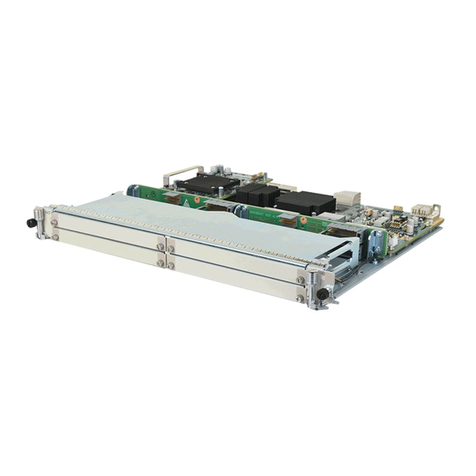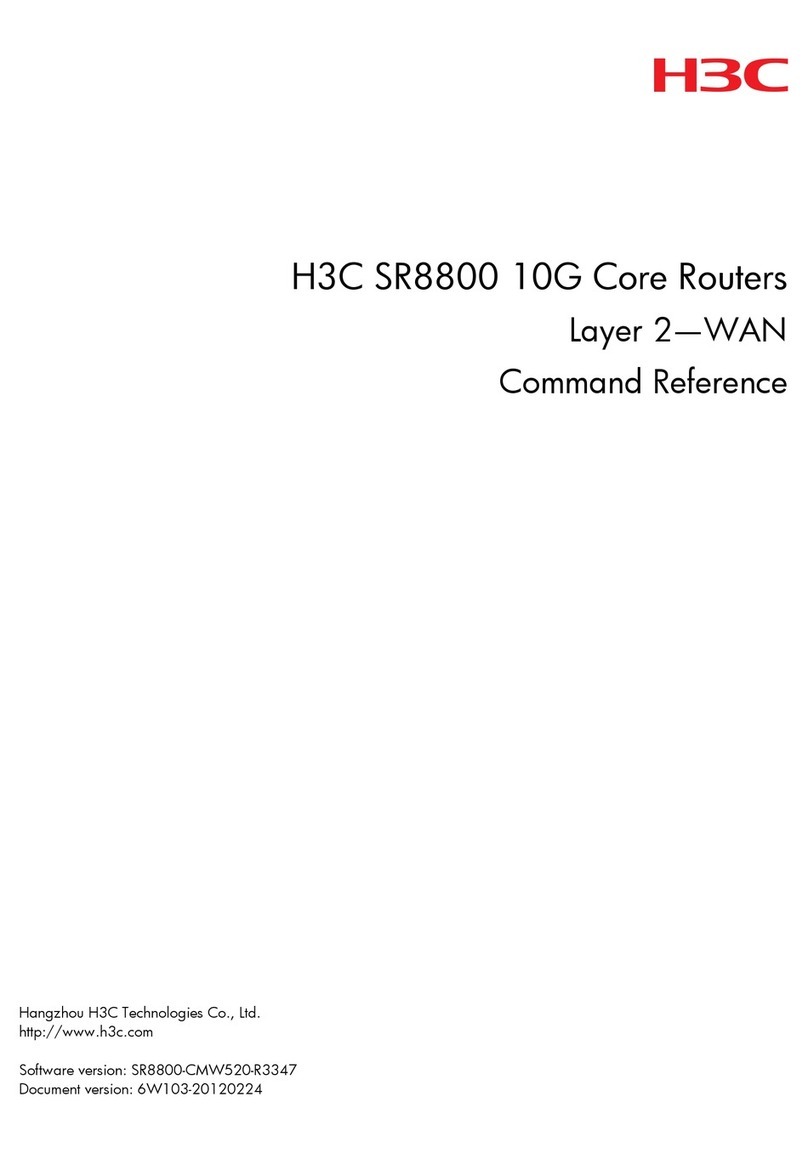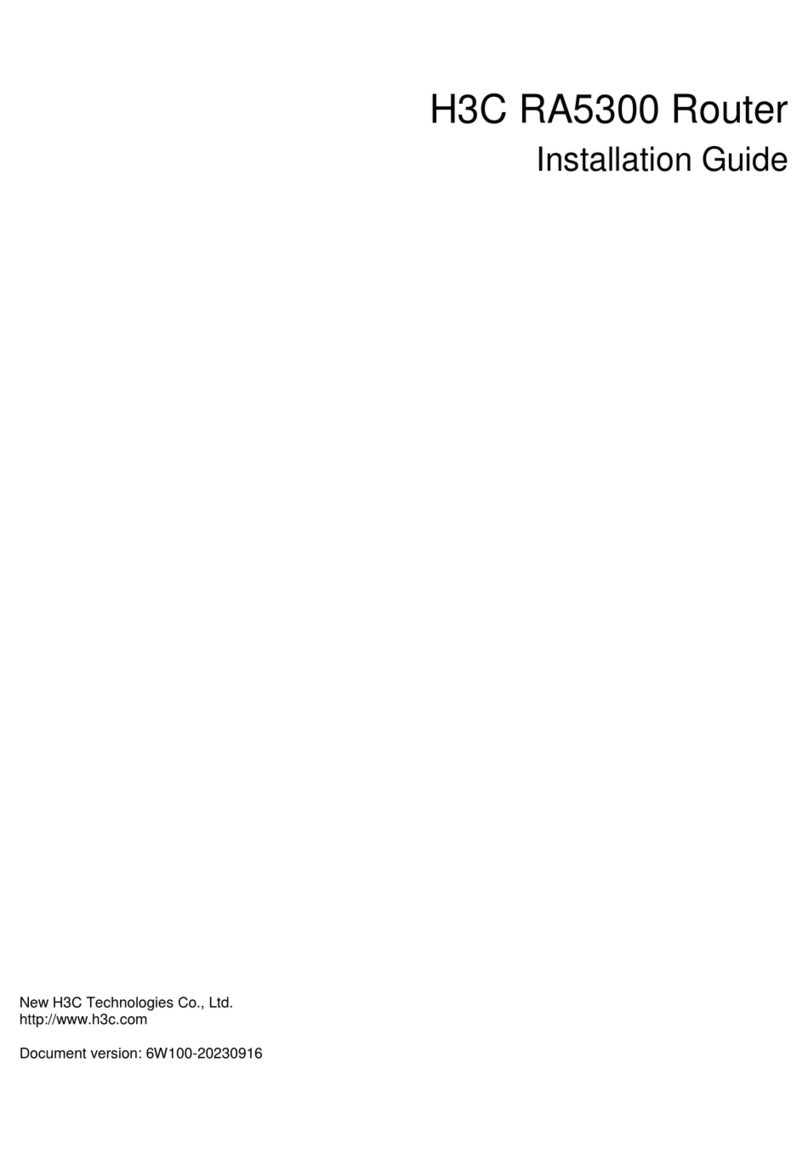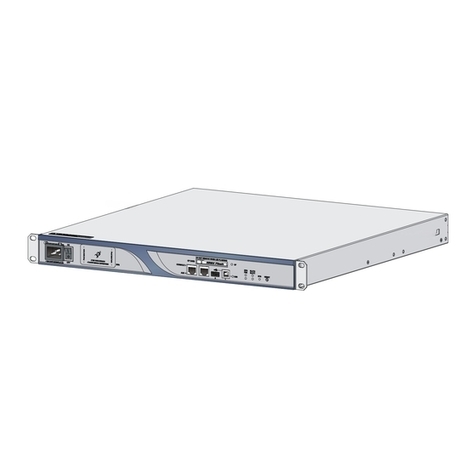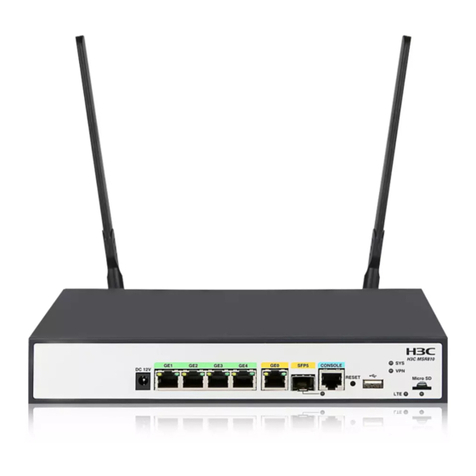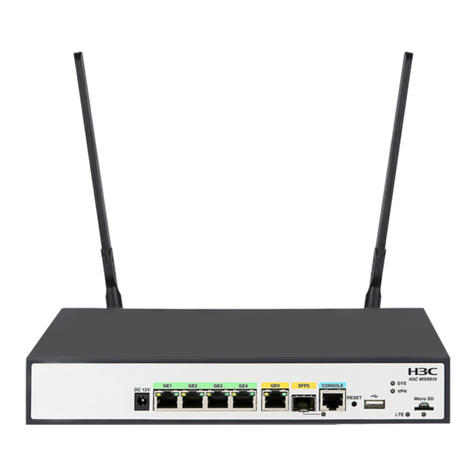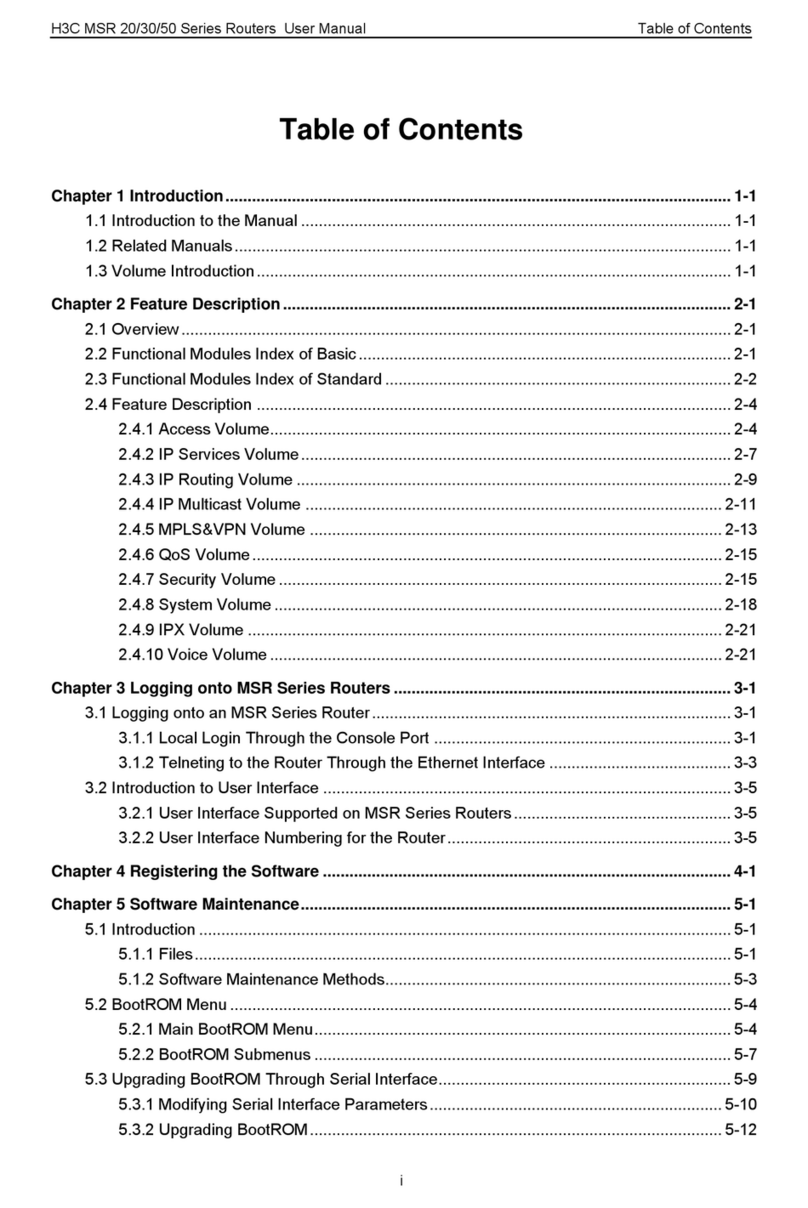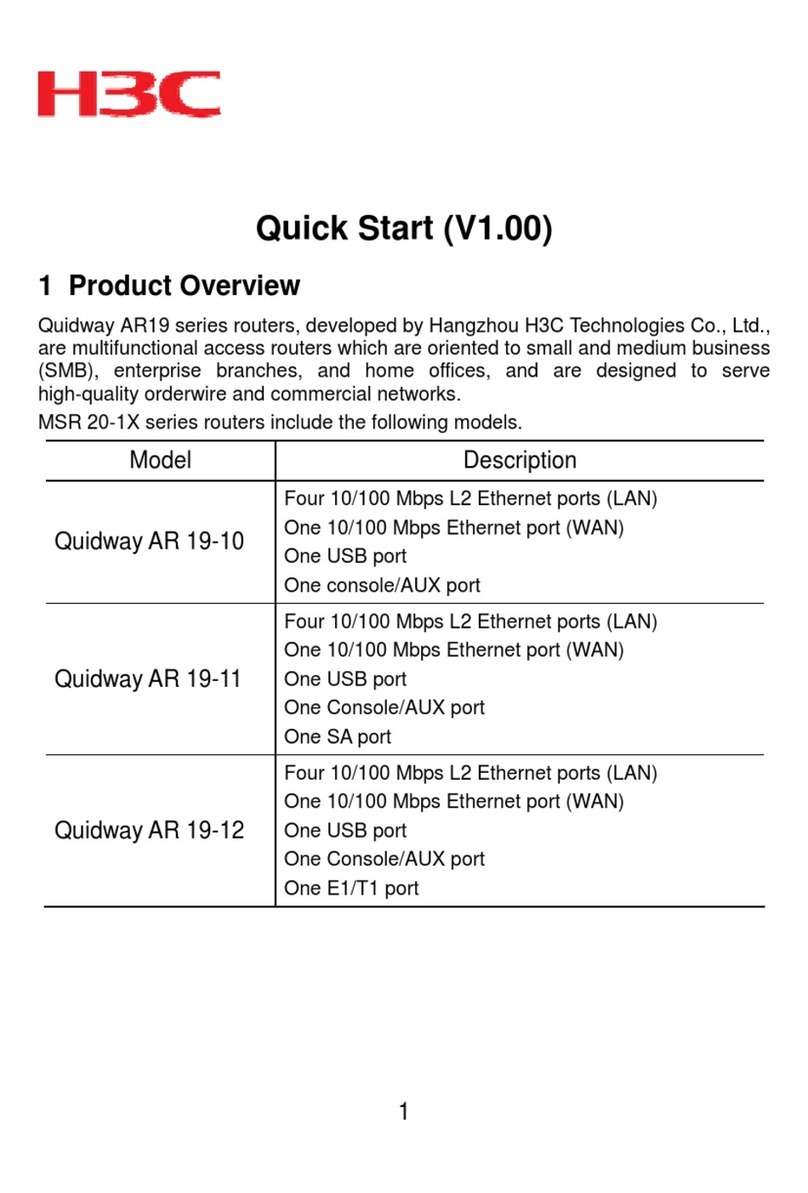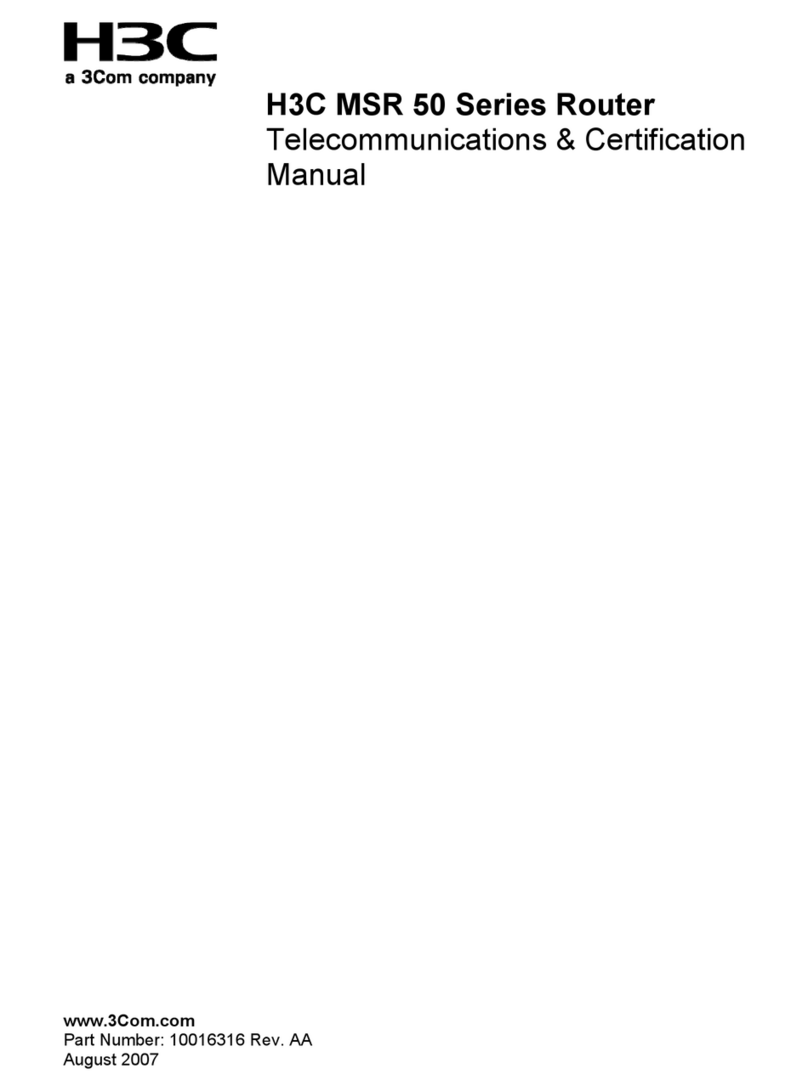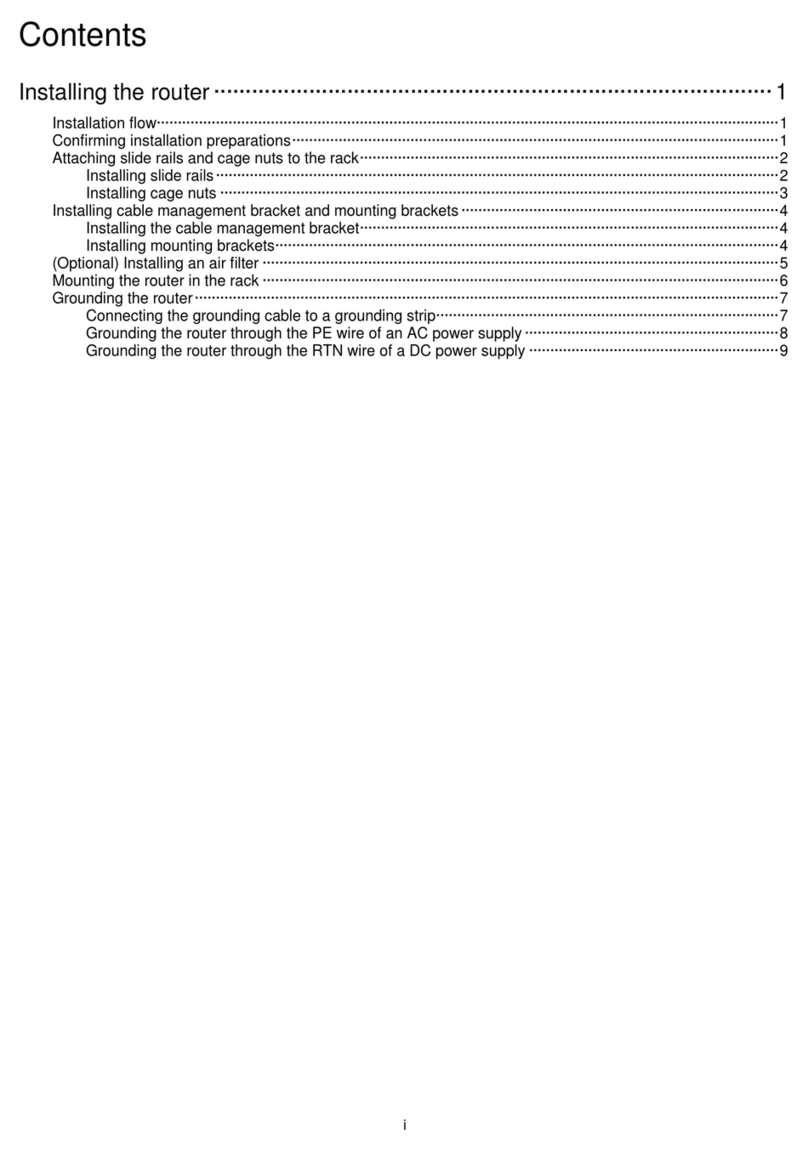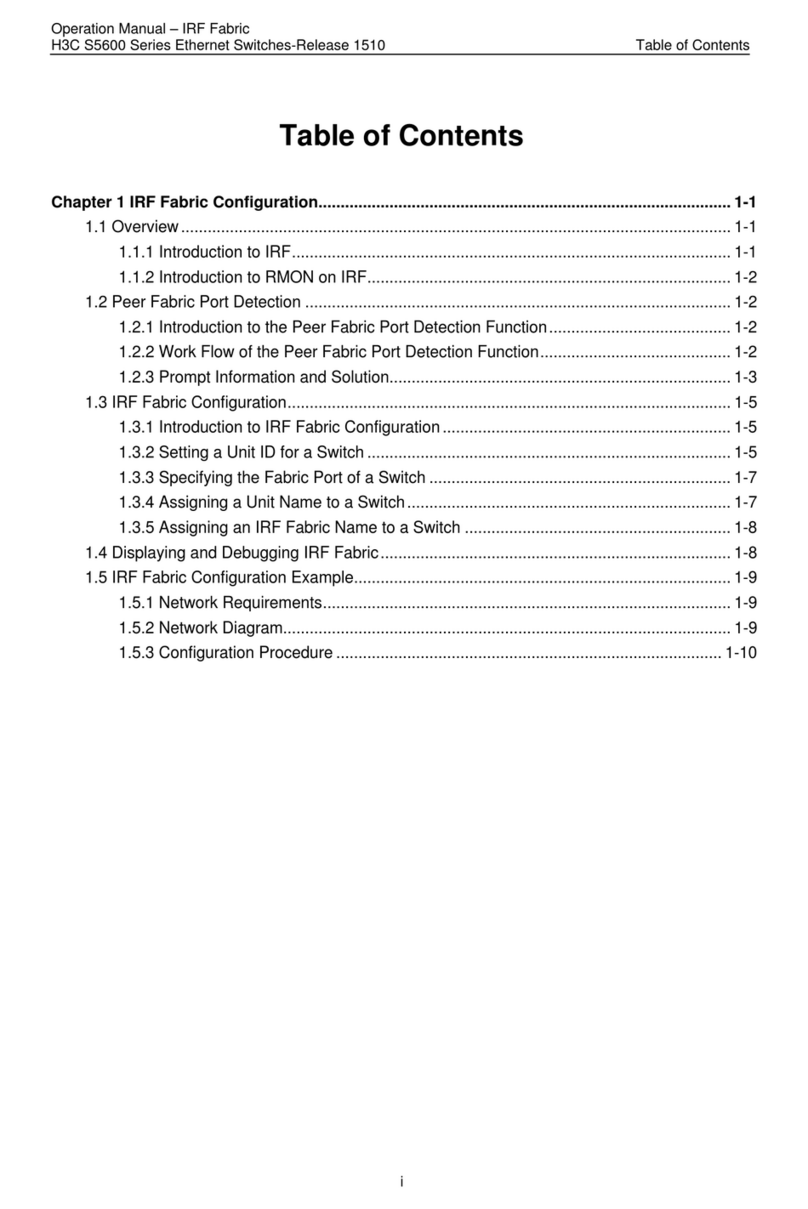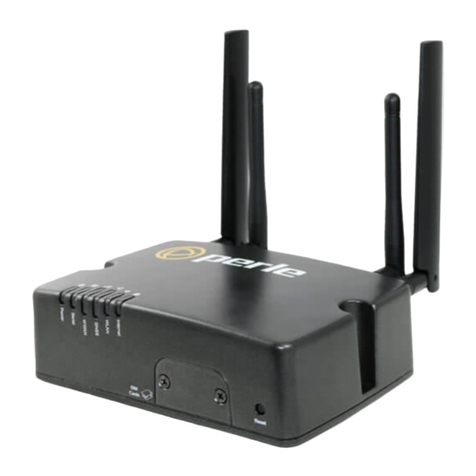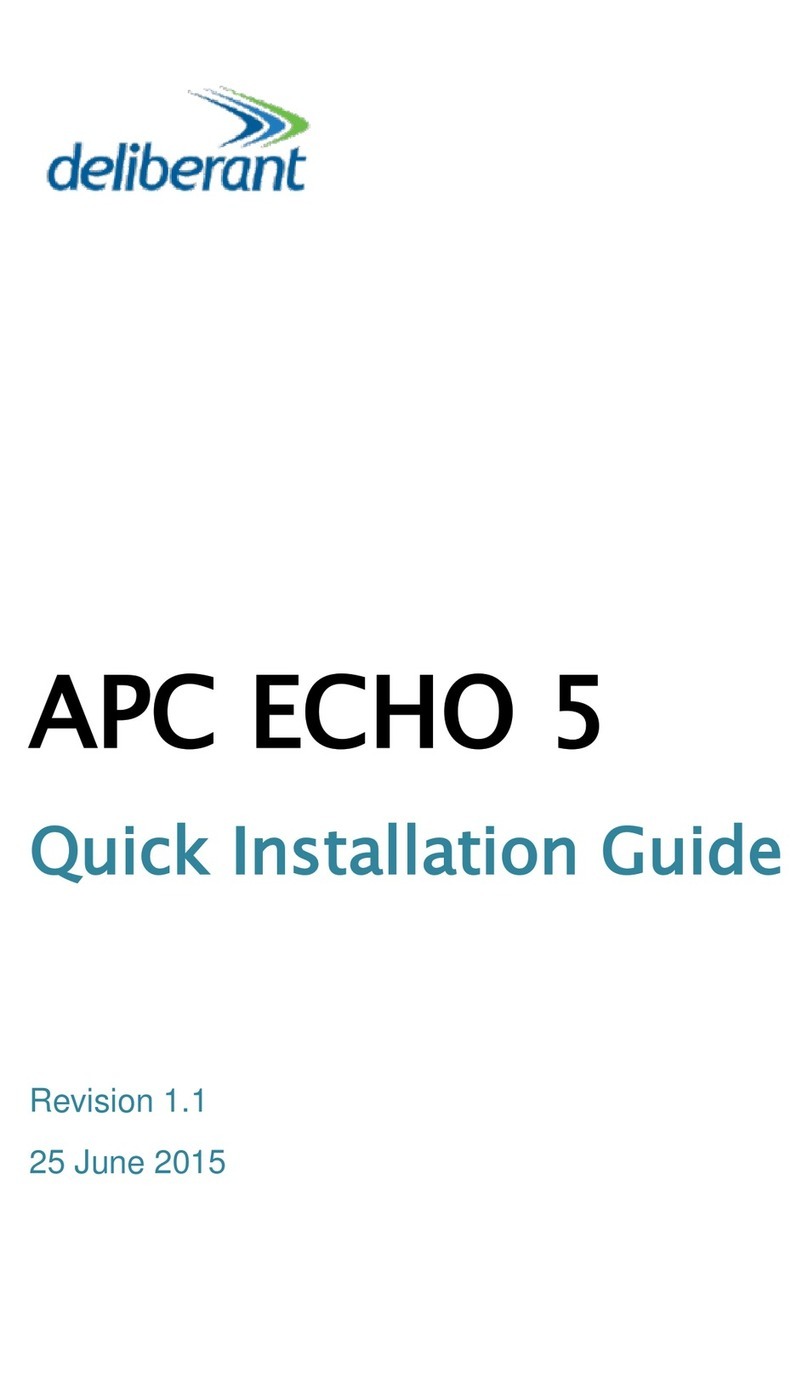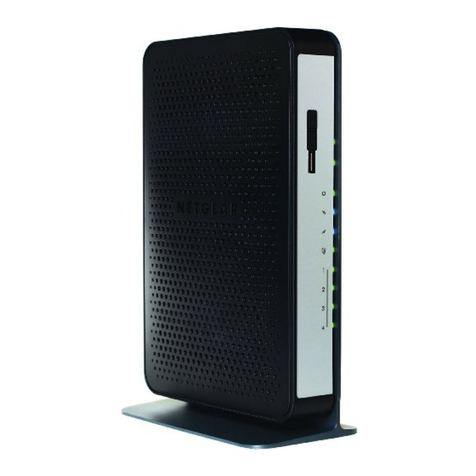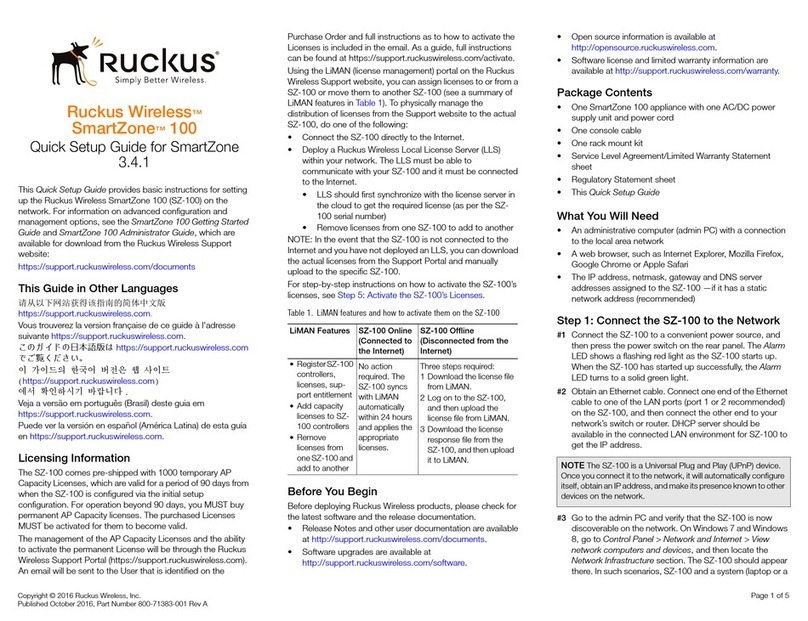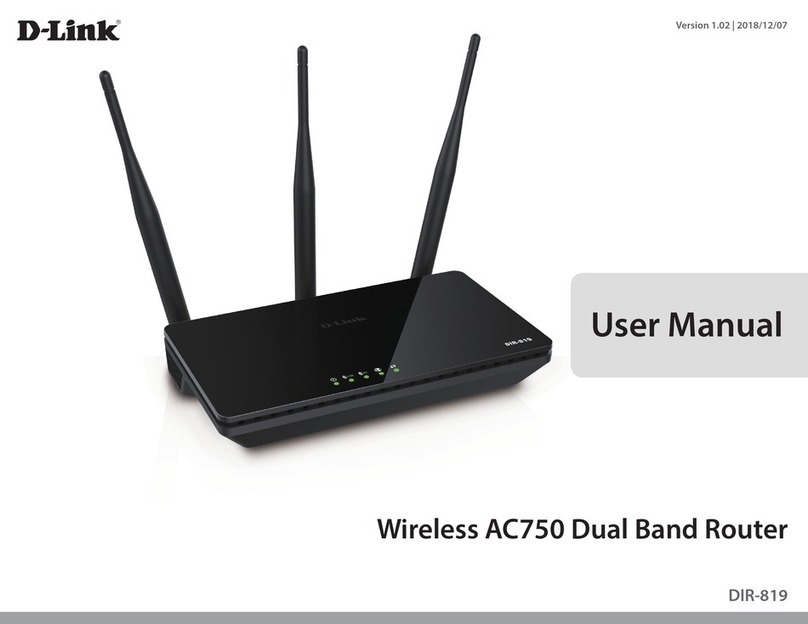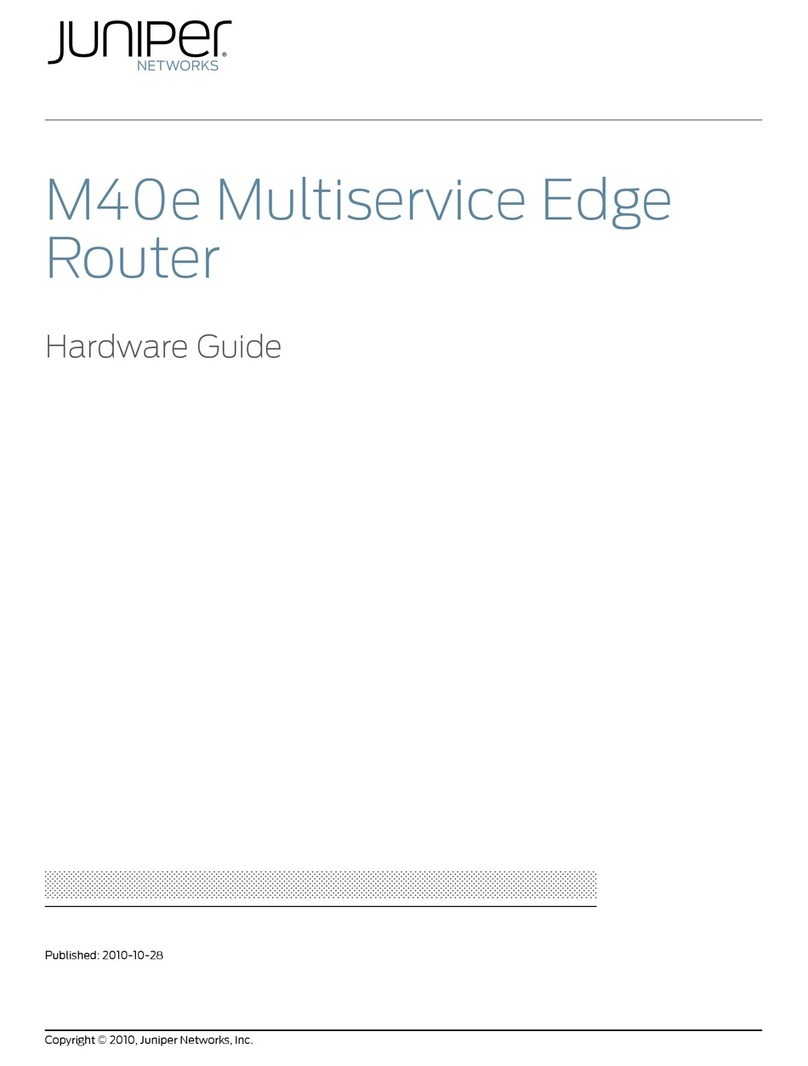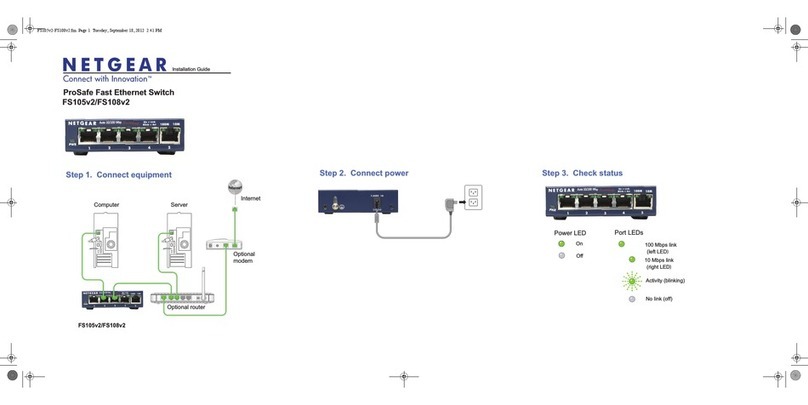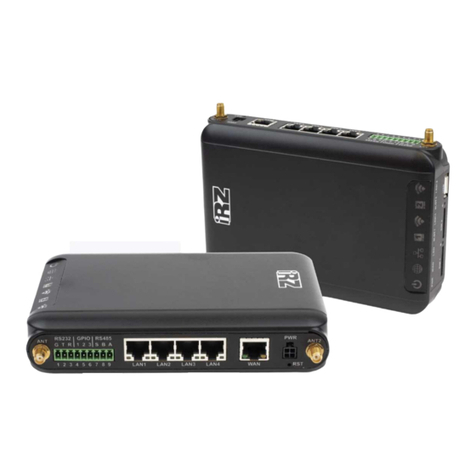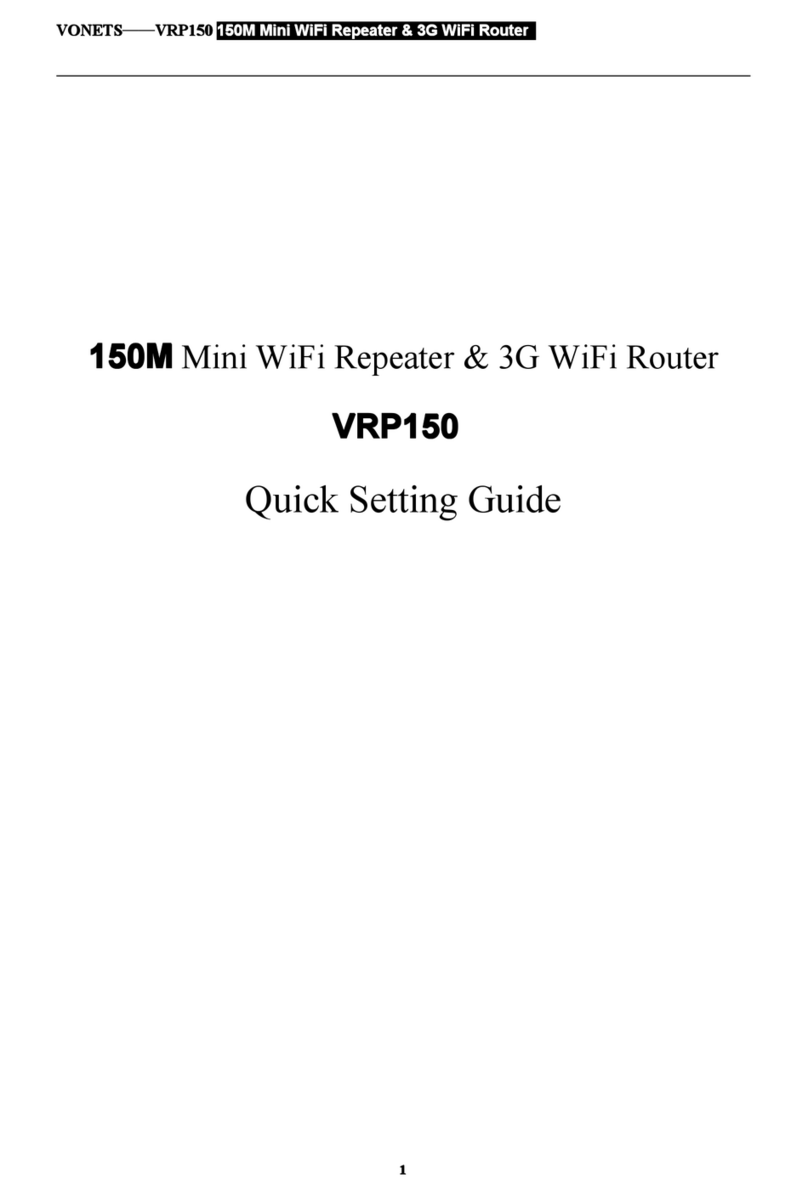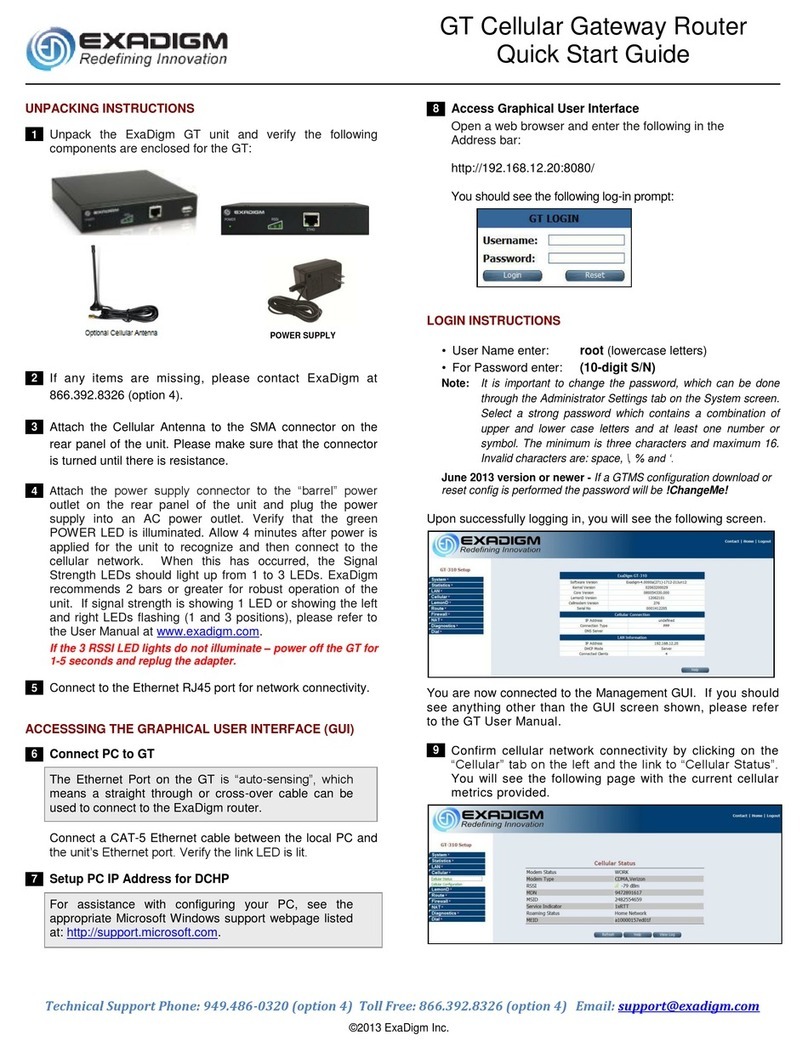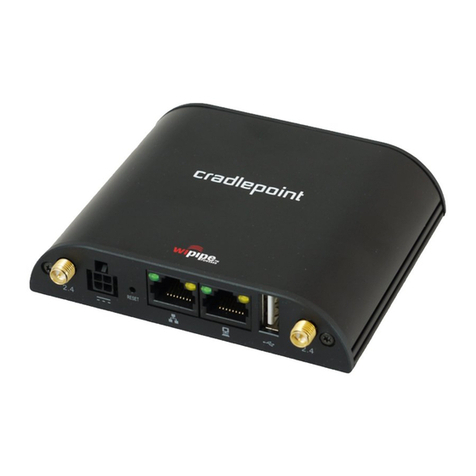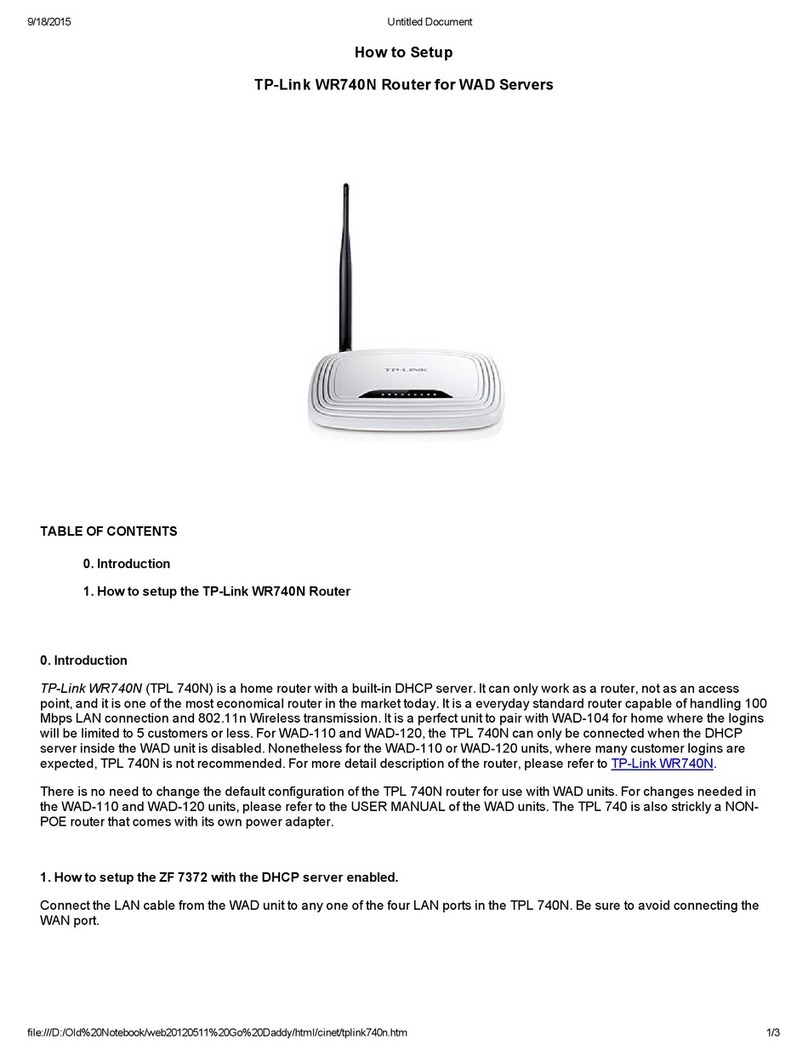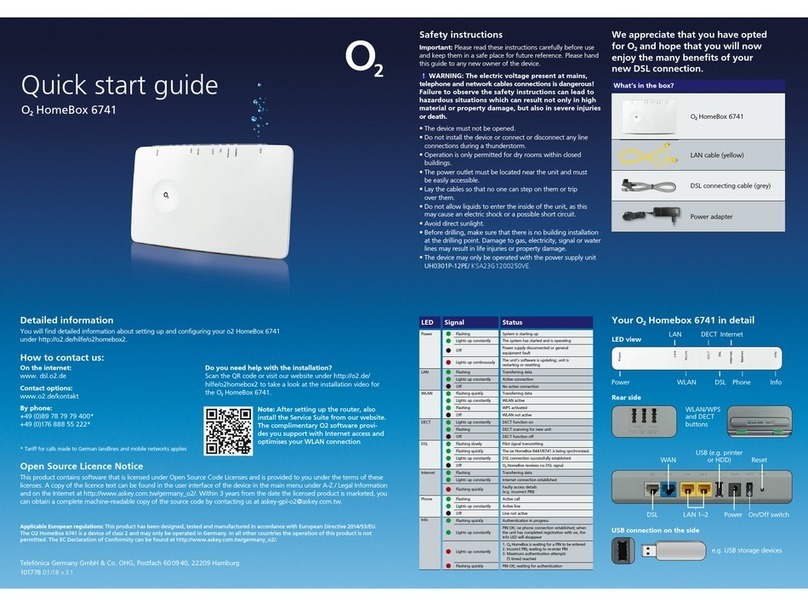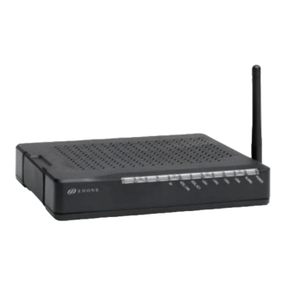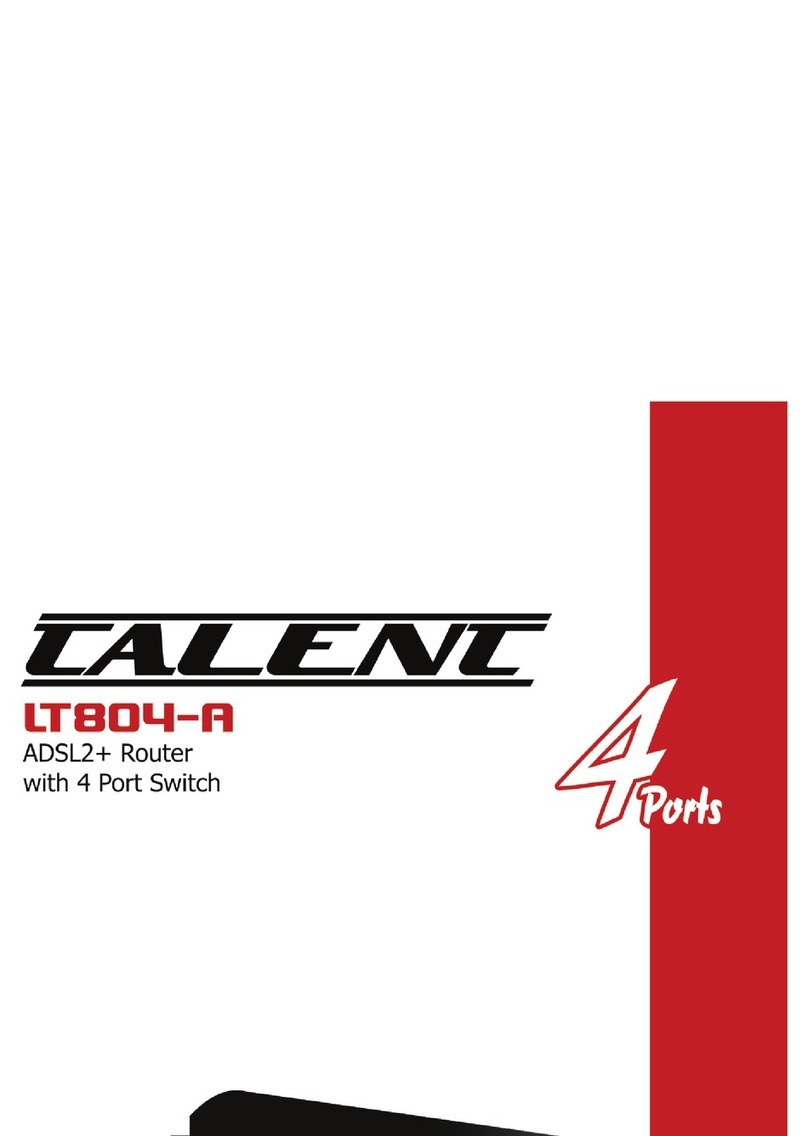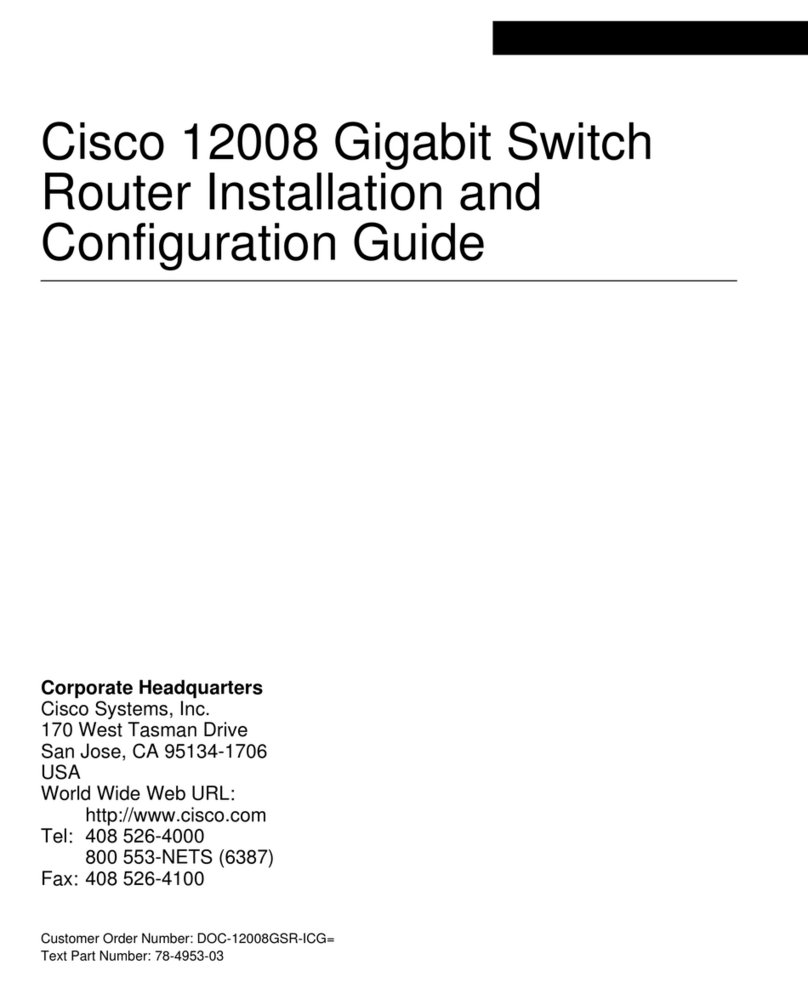H3C MSR 2600 Series User manual

H3C MSR Series Routers
Layer 3 - IP Services Configuration Guide(V7)
Hangzhou H3C Technologies Co., Ltd.
http://www.h3c.com
Software version: MSR-CMW710-R0007
Document version: 6W100-20140320

Copyright © 2014, Hangzhou H3C Technologies Co., Ltd. and its licensors
All rights reserved
No part of this manual may be reproduced or transmitted in any form or by any means without prior
written consent of Hangzhou H3C Technologies Co., Ltd.
Trademarks
H3C, , H3CS, H3CIE, H3CNE, Aolynk, , H3Care, , IRF, NetPilot, Netflow,
SecEngine, SecPath, SecCenter, SecBlade, Comware, ITCMM and HUASAN are trademarks of
Hangzhou H3C Technologies Co., Ltd.
All other trademarks that may be mentioned in this manual are the property of their respective owners
Notice
The information in this document is subject to change without notice. Every effort has been made in the
preparation of this document to ensure accuracy of the contents, but all statements, information, and
recommendations in this document do not constitute the warranty of any kind, express or implied.

Preface
The H3C MSR documentation set includes 14 configuration guides, which describe the software features
for the H3C MSR Series Routers and guide you through the software configuration procedures. These
configuration guides also provide configuration examples to help you apply software features to different
network scenarios.
The Layer 3 - IP Services Configuration Guide(V7) describes IPv4/IPv6 fundamentals and configuration,
such as IP addressing, ARP, DNS, DHCP, NAT, GRE, and tunneling configuration.
This preface includes:
•Audience
•Conventions
•About the H3C MSR documentation set
•Obtaining documentation
•Technical support
•Documentation feedback
These configuration guides apply to the following models of the H3C MSR series routers:
Model
MSR 2600 •MSR 26-30
MSR 3600
•MSR 36-10
•MSR 36-20
•MSR 36-40
•MSR 36-60
•MSR3600-28
•MSR3600-51
MSR 5600
•MSR 56-60
•MSR 56-80
Audience
This documentation is intended for:
•Network planners
•Field technical support and servicing engineers
•Network administrators working with the routers

Conventions
This section describes the conventions used in this documentation set.
Command conventions
Convention Descri
p
tion
Boldface Bold text represents commands and keywords that you enter literally as shown.
Italic Italic text represents arguments that you replace with actual values.
[ ] Square brackets enclose syntax choices (keywords or arguments) that are optional.
{ x | y | ... }
Braces enclose a set of required syntax choices separated by vertical bars, from which
you select one.
[ x | y | ... ]
Square brackets enclose a set of optional syntax choices separated by vertical bars, from
which you select one or none.
{ x | y | ... } *
Asterisk marked braces enclose a set of required syntax choices separated by vertical
bars, from which you select at least one.
[ x | y | ... ] *
Asterisk marked square brackets enclose optional syntax choices separated by vertical
bars, from which you select one choice, multiple choices, or none.
&<1-n> The argument or keyword and argument combination before the ampersand (&) sign can
be entered 1 to n times.
# A line that starts with a pound (#) sign is comments.
Symbols
Convention Descri
p
tion
WARNING An alert that calls attention to important information that if not understood or followed can
result in personal injury.
CAUTION An alert that calls attention to important information that if not understood or followed can
result in data loss, data corruption, or damage to hardware or software.
IMPORTANT An alert that calls attention to essential information.
NOTE An alert that contains additional or supplementary information.
TIP An alert that provides helpful information.
Network topology icons
Represents a generic network device, such as a router, switch, or firewall.
Represents a routing-capable device, such as a router or Layer 3 switch.
Represents a generic switch, such as a Layer 2 or Layer 3 switch, or a router that supports
Layer 2 forwarding and other Layer 2 features.
Port numbering in examples
The port numbers in this document are for illustration only and might be unavailable on your device.

About the H3C MSR documentation set
The H3C MSR documentation set includes:
Cate
g
or
y
Documents
Pur
p
oses
Product description and
specifications Marketing brochures Describe product specifications and benefits.
Hardware specifications
and installation
Installation guide Provides a complete guide to hardware installation
and hardware specifications.
MSR Series Routers
Interface Module Manual
Provide the hardware specifications of cards.
Software configuration
MSR Series Routers
Configuration guides(v7)
Describe software features and configuration
procedures.
MSR Series Routers
Command references(v7)
Provide a quick reference to all available
commands.
Operations and
maintenance Release notes
Provide information about the product release,
including the version history, hardware and software
compatibility matrix, version upgrade information,
technical support information, and software
upgrading.
Obtaining documentation
You can access the most up-to-date H3C product documentation on the World Wide Web
at http://www.h3c.com.
Click the links on the top navigation bar to obtain different categories of product documentation:
[Technical Support & Documents > Technical Documents]—Provides hardware installation, software
upgrading, and software feature configuration and maintenance documentation.
[Products & Solutions]—Provides information about products and technologies, as well as solutions.
[Technical Support & Documents > Software Download]—Provides the documentation released with the
software version.
Technical support
servic[email protected]
http://www.h3c.com
Documentation feedback
You can e-mail your comments about product documentation to info@h3c.com.

We appreciate your comments.

i
Contents
Configuring ARP··························································································································································· 1
Overview············································································································································································1
ARP message format ················································································································································1
ARP operating mechanism ······································································································································1
ARP table···································································································································································2
Configuring a static ARP entry·········································································································································3
Setting the maximum number of dynamic ARP entries for a device ············································································4
Setting the maximum number of dynamic ARP entries for an interface ······································································4
Setting the aging timer for dynamic ARP entries ···········································································································5
Enabling dynamic ARP entry check ································································································································5
Enabling ARP log output···················································································································································5
Displaying and maintaining ARP·····································································································································6
Static ARP configuration example ···································································································································6
Network requirements··············································································································································6
Configuration procedure ·········································································································································7
Configuring gratuitous ARP ········································································································································· 8
Overview············································································································································································8
Gratuitous ARP packet learning······························································································································8
Periodic sending of gratuitous ARP packets ··········································································································8
Configuration procedure··················································································································································9
Enabling IP conflict notification ···································································································································· 10
Configuring proxy ARP··············································································································································11
Enabling common proxy ARP ······································································································································· 11
Enabling local proxy ARP·············································································································································· 11
Displaying proxy ARP···················································································································································· 12
Common proxy ARP configuration example··············································································································· 12
Network requirements··········································································································································· 12
Configuration procedure ······································································································································ 12
Configuring ARP snooping········································································································································14
Configuration procedure··············································································································································· 14
Displaying and maintaining ARP snooping ················································································································ 14
Configuring ARP fast-reply·········································································································································16
Overview········································································································································································· 16
Function ·································································································································································· 16
Operation······························································································································································· 16
Configuration procedure··············································································································································· 16
ARP fast-reply configuration example ·························································································································· 17
Network requirements··········································································································································· 17
Configuration procedure ······································································································································ 17
Configuring IP addressing·········································································································································19
Overview········································································································································································· 19
IP address classes·················································································································································· 19
Special IP addresses ············································································································································· 20
Subnetting and masking ······································································································································· 20
Assigning an IP address to an interface ······················································································································ 21
Configuration guidelines ······································································································································ 21

ii
Configuration procedure ······································································································································ 21
Configuring IP unnumbered ·········································································································································· 21
Configuration guidelines ······································································································································ 22
Configuration prerequisites ·································································································································· 22
Configuration procedure ······································································································································ 22
Displaying and maintaining IP addressing ················································································································· 22
IP address configuration example ································································································································ 23
Network requirements··········································································································································· 23
Configuration procedure ······································································································································ 23
Verifying the configuration··································································································································· 23
IP unnumbered configuration example ························································································································ 24
Network requirements··········································································································································· 24
Configuration procedure ······································································································································ 25
Verifying the configuration··································································································································· 25
DHCP overview ··························································································································································27
DHCP address allocation ·············································································································································· 27
Allocation mechanisms ········································································································································· 27
Dynamic IP address allocation process··············································································································· 28
IP address lease extension···································································································································· 28
DHCP message format··················································································································································· 29
DHCP options ································································································································································· 30
Common DHCP options········································································································································ 30
Custom DHCP options··········································································································································· 30
Protocols and standards ················································································································································ 32
Configuring the DHCP server····································································································································33
Overview········································································································································································· 33
DHCP address pool··············································································································································· 33
IP address allocation sequence···························································································································· 35
DHCP server configuration task list ······························································································································ 35
Configuring an address pool on the DHCP server····································································································· 35
Configuration task list ··········································································································································· 35
Creating a DHCP address pool··························································································································· 36
Specifying IP address ranges for a DHCP address pool ·················································································· 36
Specifying gateways for the client······················································································································· 39
Specifying a domain name suffix for the client·································································································· 40
Specifying DNS servers for the client·················································································································· 40
Specifying WINS servers and NetBIOS node type for the client····································································· 41
Specifying BIMS server information for the client ······························································································ 41
Specifying the TFTP server and boot file name for the client············································································ 42
Specifying a server for the DHCP client·············································································································· 42
Configuring Option 184 parameters for the client···························································································· 43
Configuring self-defined DHCP options ·············································································································· 43
Enabling DHCP ······························································································································································ 44
Enabling the DHCP server on an interface·················································································································· 44
Applying an address pool on an interface ················································································································· 45
Configuring IP address conflict detection···················································································································· 45
Enabling handling of Option 82·································································································································· 46
Configuring DHCP server compatibility······················································································································· 46
Configuring the DHCP server to broadcast all responses················································································· 46
Configure the DHCP server to ignore BOOTP requests ···················································································· 46
Configuring the DHCP server to send BOOTP responses in RFC 1048 format·············································· 47
Setting the DSCP value for DHCP packets sent by the DHCP server········································································ 47
Displaying and maintaining the DHCP server ············································································································ 48

iii
DHCP server configuration examples ·························································································································· 48
Static IP address assignment configuration example························································································· 48
Dynamic IP address assignment configuration example··················································································· 50
DHCP user class configuration example············································································································· 51
Self-defined DHCP option configuration example ····························································································· 52
Troubleshooting DHCP server configuration ··············································································································· 53
Symptom································································································································································· 53
Analysis ·································································································································································· 53
Solution··································································································································································· 53
Configuring the DHCP relay agent···························································································································55
Overview········································································································································································· 55
Operation······························································································································································· 55
DHCP relay agent support for Option 82 ·········································································································· 56
DHCP relay agent configuration task list····················································································································· 56
Enabling DHCP ······························································································································································ 57
Enabling the DHCP relay agent on an interface ········································································································ 57
Specifying DHCP servers on a relay agent················································································································· 57
Configuring the DHCP relay agent security functions ································································································ 58
Enabling the DHCP relay agent to record relay entries···················································································· 58
Enabling periodic refresh of dynamic relay entries··························································································· 58
Enabling DHCP starvation attack protection ······································································································ 59
Configuring the DHCP relay agent to release an IP address ···················································································· 60
Configuring Option 82 ················································································································································· 60
Setting the DSCP value for DHCP packets sent by the DHCP relay agent······························································· 61
Displaying and maintaining the DHCP relay agent ··································································································· 61
DHCP relay agent configuration examples················································································································· 61
DHCP relay agent configuration example·········································································································· 61
Option 82 configuration example······················································································································· 62
Troubleshooting DHCP relay agent configuration······································································································ 63
Symptom································································································································································· 63
Analysis ·································································································································································· 63
Solution··································································································································································· 63
Configuring the DHCP client ·····································································································································64
Enabling the DHCP client on an interface··················································································································· 64
Configuring a DHCP client ID for an interface ··········································································································· 64
Enabling duplicated address detection ······················································································································· 65
Setting the DSCP value for DHCP packets sent by the DHCP client ········································································· 65
Displaying and maintaining the DHCP client·············································································································· 66
DHCP client configuration example ····························································································································· 66
Network requirements··········································································································································· 66
Configuration procedure ······································································································································ 67
Verifying the configuration··································································································································· 67
Configuring DHCP snooping·····································································································································69
Overview········································································································································································· 69
Application of trusted and untrusted ports·········································································································· 69
DHCP snooping support for Option 82·············································································································· 70
DHCP snooping configuration task list ························································································································ 71
Configuring basic DHCP snooping······························································································································ 71
Configuring Option 82 ················································································································································· 72
Saving DHCP snooping entries ···································································································································· 73
Enabling DHCP starvation attack protection ··············································································································· 74
Enabling DHCP-REQUEST attack protection ··············································································································· 74
Configuring DHCP packet rate limit····························································································································· 75

iv
Displaying and maintaining DHCP snooping ············································································································· 75
DHCP snooping configuration examples····················································································································· 76
Basic DHCP snooping configuration example ··································································································· 76
Option 82 configuration example······················································································································· 77
Configuring the BOOTP client···································································································································79
BOOTP application························································································································································ 79
Obtaining an IP address dynamically ························································································································· 79
Protocols and standards ················································································································································ 79
Configuring an interface to use BOOTP for IP address acquisition·········································································· 80
Displaying and maintaining BOOTP client ················································································································· 80
BOOTP client configuration example ·························································································································· 80
Network requirements··········································································································································· 80
Configuration procedure ······································································································································ 80
Configuring DNS ·······················································································································································81
Overview········································································································································································· 81
Static domain name resolution····························································································································· 81
Dynamic domain name resolution······················································································································· 81
DNS proxy ····························································································································································· 82
DNS spoofing ························································································································································ 83
DNS configuration task list············································································································································ 84
Configuring the IPv4 DNS client ·································································································································· 85
Configuring static domain name resolution········································································································ 85
Configuring dynamic domain name resolution·································································································· 85
Configuring the IPv6 DNS client ·································································································································· 86
Configuring static domain name resolution········································································································ 86
Configuring dynamic domain name resolution·································································································· 87
Configuring the DNS proxy ·········································································································································· 87
Configuring DNS spoofing ··········································································································································· 88
Specifying the source interface for DNS packets ······································································································· 88
Configuring the DNS trusted interface························································································································· 89
Specifying the DSCP value for outgoing DNS packets······························································································ 90
Displaying and maintaining IPv4 DNS························································································································ 90
IPv4 DNS configuration examples ······························································································································· 90
Static domain name resolution configuration example ····················································································· 90
Dynamic domain name resolution configuration example ··············································································· 91
DNS proxy configuration example······················································································································ 94
IPv6 DNS configuration examples ······························································································································· 96
Static domain name resolution configuration example ····················································································· 96
Dynamic domain name resolution configuration example ··············································································· 96
DNS proxy configuration example····················································································································101
Troubleshooting IPv4 DNS configuration ··················································································································102
Symptom·······························································································································································102
Solution·································································································································································102
Troubleshooting IPv6 DNS configuration ··················································································································102
Symptom·······························································································································································102
Solution·································································································································································102
Configuring DDNS·················································································································································· 104
Overview·······································································································································································104
DDNS application ···············································································································································104
DDNS client configuration task list·····························································································································105
Configuring a DDNS policy········································································································································105
Configuration prerequisites ································································································································106
Configuration procedure ····································································································································106

v
Applying the DDNS policy to an interface················································································································107
Specifying the DSCP value for outgoing DDNS packets ·························································································107
Displaying DDNS·························································································································································108
DDNS configuration examples ···································································································································108
DDNS configuration example with www.3322.org ·······················································································108
DDNS configuration example with PeanutHull server·····················································································109
Configuring NAT····················································································································································· 111
Terminology ··································································································································································111
NAT device ··························································································································································111
NAT interface ······················································································································································111
NAT address························································································································································112
NAT entry·····························································································································································112
NAT types ·····································································································································································112
Traditional NAT···················································································································································112
Bidirectional NAT················································································································································112
Twice NAT ···························································································································································112
Easy IP ··································································································································································112
NAT translation control ···············································································································································112
NAT features·································································································································································113
Static NAT····························································································································································113
Dynamic NAT ······················································································································································113
NAT Server ··························································································································································114
NAT hairpin ·························································································································································115
NAT entries···································································································································································116
NAT session entry················································································································································116
EIM entry ······························································································································································116
NO-PAT entry·······················································································································································116
Using NAT with other features····································································································································116
NAT with MPLS VPNs ·········································································································································116
NAT with DNS mapping ····································································································································117
NAT with ALG ·····················································································································································117
NAT configuration task list··········································································································································118
Configuring static NAT················································································································································118
Configuration prerequisites ································································································································118
Configuring outbound one-to-one static NAT···································································································118
Configuring outbound net-to-net static NAT ·····································································································119
Configuring inbound one-to-one static NAT ·····································································································120
Configuring inbound net-to-net static NAT········································································································120
Configuring dynamic NAT··········································································································································121
Configuration restrictions and guidelines ·········································································································121
Configuration prerequisites ································································································································121
Configuring outbound dynamic NAT················································································································121
Configuring inbound dynamic NAT··················································································································122
Configuring NAT Server··············································································································································123
Configuring common NAT Server ·····················································································································123
Configuring load sharing NAT Server ··············································································································124
Configuring NAT with DNS mapping ·······················································································································125
Configuring NAT hairpin ············································································································································125
Configuring NAT with ALG·········································································································································125
Configuring NAT logging ···········································································································································126
Displaying and maintaining NAT·······························································································································126
NAT configuration examples ······································································································································127
One-to-one static NAT for internal-to-external access······················································································127
Outbound dynamic NAT for internal-to-external access (non-overlapping addresses)································129

vi
Bidirectional NAT for internal-to-external access ·····························································································131
NAT Server for external-to-internal access········································································································133
NAT Server for external-to-internal access through domain name·································································136
Bidirectional NAT for external-to-internal access through NAT Server··························································138
NAT hairpin in C/S mode ·································································································································141
NAT hairpin in P2P mode for access between internal users·········································································144
Twice NAT for access between two VPNs with overlapping addresses ·······················································146
Load sharing NAT Server configuration example ···························································································148
NAT with DNS mapping configuration example·····························································································150
Basic IP forwarding on the device ························································································································· 154
FIB table ········································································································································································154
Displaying FIB table entries·········································································································································154
Configuring fast forwarding··································································································································· 156
Overview·······································································································································································156
Configuration procedure·············································································································································156
Displaying and maintaining fast forwarding ············································································································156
Fast forwarding configuration example·····················································································································157
Network requirements·········································································································································157
Configuration procedure ····································································································································157
Verifying the configuration·································································································································158
Displaying the adjacency table ····························································································································· 159
Optimizing IP performance ···································································································································· 161
Enabling an interface to receive and forward directed broadcasts destined for the directly connected network
·······················································································································································································161
Configuration procedure ····································································································································161
Configuration example ·······································································································································162
Configuring MTU for an interface ······························································································································162
Configuring TCP MSS for an interface ······················································································································163
Configuring TCP path MTU discovery ·······················································································································163
Enabling TCP SYN Cookie··········································································································································164
Configuring the TCP buffer size··································································································································165
Configuring TCP timers················································································································································165
Enabling sending ICMP error packets ·······················································································································165
Configuring rate limit for ICMP error messages ·······································································································167
Specifying the source address for ICMP packets ·····································································································167
Configuring IP virtual fragment reassembly ··············································································································168
Configuration guidelines ····································································································································168
Configuration procedure ····································································································································168
Configuration example ·······································································································································168
Displaying and maintaining IP performance optimization ······················································································169
Configuring UDP helper·········································································································································· 171
Overview·······································································································································································171
Configuration guidelines ·············································································································································171
Configuration procedure·············································································································································171
Displaying and maintaining UDP helper ···················································································································172
UDP helper configuration example ····························································································································172
Network requirements·········································································································································172
Configuration procedure ····································································································································172
Verifying the configuration·································································································································173
Configuring basic IPv6 settings······························································································································ 174
Overview·······································································································································································174

vii
IPv6 features·························································································································································174
IPv6 addresses·····················································································································································175
IPv6 ND protocol·················································································································································178
IPv6 path MTU discovery····································································································································180
IPv6 transition technologies·········································································································································180
Dual stack·····························································································································································180
Tunneling······························································································································································181
NAT-PT··································································································································································181
6PE········································································································································································181
Protocols and standards ··············································································································································181
IPv6 basics configuration task list·······························································································································182
Assigning IPv6 addresses to interfaces······················································································································183
Configuring an IPv6 global unicast address ····································································································183
Configuring an IPv6 link-local address ·············································································································185
Configuring an IPv6 anycast address ···············································································································186
Configuring IPv6 ND ···················································································································································186
Configuring a static neighbor entry ··················································································································186
Setting the maximum number of dynamic neighbor entries············································································187
Setting the aging timer for ND entries in stale state························································································187
Minimizing link-local ND entries························································································································188
Setting the hop limit ············································································································································188
Configuring parameters for RA messages········································································································188
Configuring the maximum number of attempts to send an NS message for DAD·······································191
Enabling ND proxy ·············································································································································191
Configuring path MTU discovery ·······························································································································193
Configuring the interface MTU ··························································································································193
Configuring a static path MTU for a specific IPv6 address ············································································193
Configuring the aging time for dynamic path MTUs·······················································································193
Controlling sending ICMPv6 packets·························································································································194
Configuring the rate limit for ICMPv6 error messages····················································································194
Enabling replying to multicast echo requests ···································································································194
Enabling sending ICMPv6 destination unreachable messages······································································194
Enabling sending ICMPv6 time exceeded messages······················································································195
Enabling sending ICMPv6 redirect messages ··································································································195
Specifying the source address for ICMPv6 packets ·································································································196
Displaying and maintaining IPv6 basics ···················································································································196
IPv6 basics configuration example ····························································································································198
Network requirements·········································································································································198
Configuration procedure ····································································································································199
Verifying the configuration·································································································································199
Troubleshooting IPv6 basics configuration················································································································203
Symptom·······························································································································································203
Solution·································································································································································203
DHCPv6 overview··················································································································································· 204
DHCPv6 address/prefix assignment··························································································································204
Rapid assignment involving two messages·······································································································204
Assignment involving four messages·················································································································204
Address/prefix lease renewal ····································································································································205
Stateless DHCPv6·························································································································································206
Protocols and standards ··············································································································································206
Configuring the DHCPv6 server····························································································································· 207
Overview·······································································································································································207
IPv6 address assignment ····································································································································207

viii
IPv6 prefix assignment········································································································································207
Concepts·······························································································································································208
DHCPv6 address pool ········································································································································209
IPv6 address/prefix allocation sequence ·········································································································210
Configuration task list ··················································································································································210
Configuring IPv6 prefix assignment ···························································································································210
Configuration guidelines ····································································································································211
Configuration procedure ····································································································································211
Configuring IPv6 address assignment························································································································212
Configuration guidelines ····································································································································212
Configuration procedure ····································································································································212
Configuring network parameters assignment ···········································································································213
Configuring the DHCPv6 server on an interface ······································································································214
Configuration guidelines ····································································································································214
Configuration procedure ····································································································································214
Setting the DSCP value for DHCPv6 packets sent by the DHCPv6 server ·····························································215
Displaying and maintaining the DHCPv6 server ······································································································215
DHCPv6 server configuration examples····················································································································216
Dynamic IPv6 prefix assignment configuration example ················································································216
Dynamic IPv6 address assignment configuration example·············································································218
Configuring the DHCPv6 relay agent···················································································································· 221
Configuration guidelines ·············································································································································222
Configuration procedure·············································································································································222
Displaying and maintaining the DHCPv6 relay agent·····························································································223
DHCPv6 relay agent configuration example ············································································································223
Network requirements·········································································································································223
Configuration procedure ····································································································································223
Verifying the configuration·································································································································224
Configuring DHCPv6 snooping ····························································································································· 225
Overview·······································································································································································225
Application of trusted and untrusted ports········································································································225
H3C implementation of Option 18 and Option 37·································································································226
Option 18 for DHCPv6 snooping······················································································································226
DHCPv6 snooping support for Option 37········································································································227
DHCPv6 snooping configuration task list ··················································································································227
Configuring basic DHCPv6 snooping························································································································228
Configuring Option 18 and Option 37 ····················································································································228
Saving DHCPv6 snooping entries ······························································································································229
Setting the maximum number of DHCPv6 snooping entries····················································································230
Enabling DHCPv6-REQUEST check····························································································································230
Displaying and maintaining DHCPv6 snooping·······································································································231
DHCPv6 snooping configuration example················································································································231
Network requirements·········································································································································231
Configuration procedure ····································································································································232
Verifying the configuration·································································································································232
Configuring IPv6 fast forwarding··························································································································· 233
Overview·······································································································································································233
Configuration procedure·············································································································································233
Displaying and maintaining IPv6 fast forwarding ····································································································233
IPv6 fast forwarding configuration example ·············································································································234
Network requirements·········································································································································234
Configuration procedure ····································································································································234
Verifying the configuration·································································································································234

ix
Configuring tunneling ············································································································································· 236
Overview·······································································································································································236
IPv6 over IPv4 tunneling ·····································································································································236
IPv4 over IPv4 tunneling ·····································································································································239
IPv4 over IPv6 tunneling ·····································································································································240
IPv6 over IPv6 tunneling ·····································································································································243
Protocols and standards ·····································································································································243
Tunneling configuration task list ·································································································································244
Configuring a tunnel interface····································································································································244
Configuring an IPv6 over IPv4 manual tunnel···········································································································245
Configuration example ·······································································································································246
Configuring an automatic IPv4-compatible IPv6 tunnel ···························································································248
Configuration example ·······································································································································249
Configuring a 6to4 tunnel···········································································································································250
6to4 tunnel configuration example ···················································································································251
6to4 relay configuration example ·····················································································································253
Configuring an ISATAP tunnel ····································································································································254
Configuration example ·······································································································································255
Configuring an IPv4 over IPv4 tunnel ························································································································258
Configuration example ·······································································································································259
Configuring an IPv4 over IPv6 manual tunnel···········································································································260
Configuration example ·······································································································································261
Configuring a DS-Lite tunnel ·······································································································································263
Configuration example ·······································································································································264
Configuring an IPv6 over IPv6 tunnel ························································································································266
Configuration example ·······································································································································267
Displaying and maintaining tunneling configuration ·······························································································269
Troubleshooting tunneling configuration ···················································································································269
Symptom·······························································································································································269
Analysis ································································································································································269
Solution·································································································································································269
Configuring flow classification······························································································································· 270
Specifying a flow classification policy·······················································································································270
Index ········································································································································································ 271

1
Configuring ARP
This chapter describes how to configure the Address Resolution Protocol (ARP).
Overview
ARP resolves IP addresses into MAC addresses on Ethernet networks.
ARP message format
ARP uses two types of messages: ARP request and ARP reply. Figure 1 shows the format of ARP
request/reply messages. Numbers in the figure refer to field lengths.
Figure 1 ARP message format
•Hardware type—Hardware address type. The value 1 represents Ethernet.
•Protocol type—Type of the protocol address to be mapped. The hexadecimal value 0x0800
represents IP.
•Hardware address length and protocol address length—Length, in bytes, of a hardware address
and a protocol address. For an Ethernet address, the value of the hardware address length field is
6. For an IPv4 address, the value of the protocol address length field is 4.
•OP—Operation code, which describes the type of ARP message. Value 1 represents an ARP request,
and value 2 represents an ARP reply.
•Sender hardware address—Hardware address of the device sending the message.
•Sender protocol address—Protocol address of the device sending the message.
•Target hardware address—Hardware address of the device to which the message is being sent.
•Target protocol address—Protocol address of the device to which the message is being sent.
ARP operating mechanism
As shown in Figure 2, Host A and Host B are on the same subnet. Host A sends a packet to Host B as
follows:
1. Host A looks through the ARP table for an ARP entry for Host B. If one entry is found, Host A uses
the MAC address in the entry to encapsulate the IP packet into a data link layer frame. Then Host
A sends the frame to Host B.

2
2. If Host A finds no entry for Host B, Host A buffers the packet and broadcasts an ARP request. The
payload of the ARP request comprises the following information:
{Sender IP address and sender MAC address—Host A's IP address and MAC address.
{Target IP address—Host B's IP address.
{Target MAC address—An all-zero MAC address.
All hosts on this subnet can receive the broadcast request, but only the requested host (Host B)
processes the request.
3. Host B compares its own IP address with the target IP address in the ARP request. If they are the
same, Host B:
a. Adds the sender IP address and sender MAC address into its ARP table.
b. Encapsulates its MAC address into an ARP reply.
c. Unicasts the ARP reply to Host A.
4. After receiving the ARP reply, Host A:
a. Adds the MAC address of Host B into its ARP table.
b. Encapsulates the MAC address into the packet and sends the packet to Host B.
Figure 2 ARP address resolution process
If Host A and Host B are on different subnets, Host A sends a packet to Host B as follows:
5. Host A broadcasts an ARP request where the target IP address is the IP address of the gateway.
6. The gateway responds with its MAC address in an ARP reply to Host A.
7. Host A uses the gateway's MAC address to encapsulate the packet, and then sends the packet to
the gateway.
8. If the gateway has an ARP entry for Host B, it forwards the packet to Host B directly. If not, the
gateway broadcasts an ARP request, in which the target IP address is the IP address of Host B.
9. After the gateway gets the MAC address of Host B, it sends the packet to Host B.
ARP table
An ARP table stores dynamic and static ARP entries.
Dynamic ARP entry
ARP automatically creates and updates dynamic entries. A dynamic ARP entry is removed when its aging
timer expires or the output interface goes down. In addition, a dynamic ARP entry can be overwritten by
a static ARP entry.

3
Static ARP entry
A static ARP entry is manually configured and maintained. It does not age out and cannot be overwritten
by any dynamic ARP entry.
Static ARP entries protect communication between devices because attack packets cannot modify the
IP-to-MAC mapping in a static ARP entry.
Static ARP entries include long and short ARP entries.
•A long static ARP entry comprises the IP address, MAC address, VLAN, and output interface. It is
directly used for forwarding packets.
•A short static ARP entry comprises only the IP address and MAC address.
{If the output interface is a Layer 3 Ethernet interface, the short ARP entry can be directly used to
forward packets.
{If the output interface is a VLAN interface, the device first sends an ARP request whose target IP
address is the IP address of the short entry. If the sender IP and MAC addresses in the received
ARP reply match the IP and MAC addresses of the short static ARP entry, the device adds the
interface that received the ARP reply to the short static ARP entry, and uses the resolved short
static ARP entry to forward IP packets.
To communicate with a host by using a fixed IP-to-MAC mapping, configure a short static ARP entry on
the device. To communicate with a host by using a fixed IP-to-MAC mapping through a specific interface
in a specific VLAN, configure a long static ARP entry on the device.
Configuring a static ARP entry
A static ARP entry is effective when the device works correctly. If a VLAN or VLAN interface is deleted,
any long static ARP entry in the VLAN is deleted, and any resolved short static ARP entry in the VLAN
becomes unresolved.
A resolved short static ARP entry becomes unresolved upon certain events. For example, it becomes
unresolved when the resolved output interface goes down.
A long static ARP entry is ineffective if the IP address in the entry conflicts with a local IP address, or no
local interface has an IP address in the same subnet as the IP address in the ARP entry. An ineffective long
static ARP entry cannot be used to forward packets.
Follow these guidelines when you configure a static ARP entry:
•The vlan-id argument must be the ID of an existing VLAN where the ARP entry resides. The specified
Ethernet interface must belong to that VLAN. The VLAN interface of the VLAN must be created.
•The IP address of the VLAN interface of the VLAN specified by the vlan-id argument must belong to
the same subnet as the IP address specified by the ip-address argument.
To configure a static ARP entry:
Step Command Remarks
1. Enter system view. system-view N/A

4
Step Command Remarks
2. Configure a static ARP
entry.
•Configure a long static ARP entry:
arp static ip-address mac-address
vlan-id interface-type interface-number
[ vpn-instance vpn-instance-name ]
•Configure a short static ARP entry:
arp static ip-address mac-address
[ vpn-instance vpn-instance-name ]
Use either command.
By default, no static ARP entry is
configured.
Setting the maximum number of dynamic ARP
entries for a device
A device can dynamically learn ARP entries. To prevent a device from holding too many ARP entries, you
can set the maximum number of dynamic ARP entries that the device can learn. When the maximum
number is reached, the device stops learning ARP entries.
If you set a value lower than the number of existing dynamic ARP entries, the device does not remove the
existing entries unless they are aged out, and the device stops learning ARP entries until the number of
dynamic ARP entries is below the configured value.
To set the maximum number of dynamic ARP entries for a device:
Ste
p
Command
Remarks
1. Enter system view. system-view N/A
2. Set the maximum
number of dynamic
ARP entries for the
device.
arp max-learning-number
number
If the value for the number argument is set to
0, the device is disabled from learning
dynamic ARP entries.
Setting the maximum number of dynamic ARP
entries for an interface
An interface can dynamically learn ARP entries. To prevent an interface from holding too many ARP
entries, you can set the maximum number of dynamic ARP entries that the interface can learn. When the
maximum number is reached, the interface stops learning ARP entries.
The Layer-2 interface can learn an ARP entry only when both its maximum number and the VLAN
interface's maximum number are not reached.
To set the maximum number of dynamic ARP entries for an interface:
Step Command Remarks
3. Enter system view. system-view N/A
4. Enter interface view. interface interface-type
interface-number N/A

5
Step Command Remarks
5. Set the maximum number of
dynamic ARP entries for the
interface.
arp max-learning-num number
If the value of the number argument is set
to 0, the interface is disabled from
learning dynamic ARP entries.
Setting the aging timer for dynamic ARP entries
Each dynamic ARP entry in the ARP table has a limited lifetime, called an aging timer. The aging timer
of a dynamic ARP entry is reset each time the dynamic ARP entry is updated. A dynamic ARP entry that
is not updated before its aging timer expires is deleted from the ARP table.
To set the aging timer for dynamic ARP entries:
Step Command Remarks
1. Enter system view. system-view N/A
2. Set the aging timer for dynamic ARP
entries. arp timer aging aging-time By default, the aging time for
dynamic ARP entries is 20 minutes.
Enabling dynamic ARP entry check
The dynamic ARP entry check function controls whether the device supports dynamic ARP entries
containing multicast MAC addresses.
When dynamic ARP entry check is enabled, the device cannot learn dynamic ARP entries containing
multicast MAC addresses, and you cannot manually add static ARP entries containing multicast MAC
addresses.
When dynamic ARP entry check is disabled, the device can learn dynamic ARP entries containing
multicast MAC addresses obtained from the ARP packets sourced from a unicast MAC address. You can
also manually add static ARP entries containing multicast MAC addresses.
To enable dynamic ARP entry check:
Step Command Remarks
1. Enter system view. system-view N/A
2. Enable dynamic ARP entry check.
arp check enable By default, dynamic ARP entry check is
enabled.
Enabling ARP log output
This function enables a device to output ARP logs generated in ARP resolution.
To enable ARP log output:
Other manuals for MSR 2600 Series
2
This manual suits for next models
12
Table of contents
Other H3C Network Router manuals
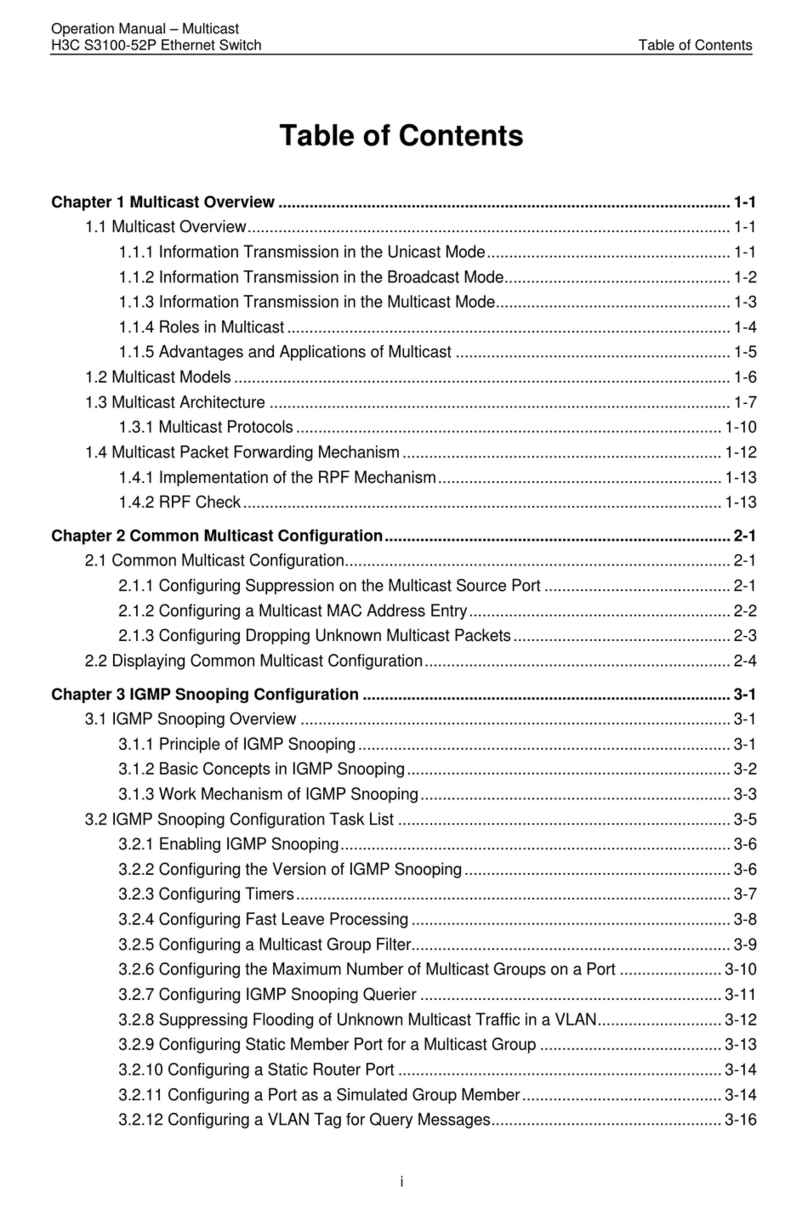
H3C
H3C S3100-52P User manual

H3C
H3C SR8800-F User manual
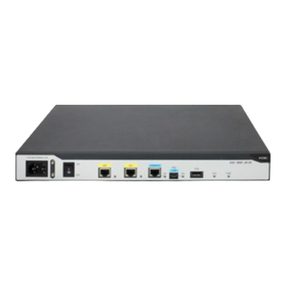
H3C
H3C MSR 2600 Series User manual
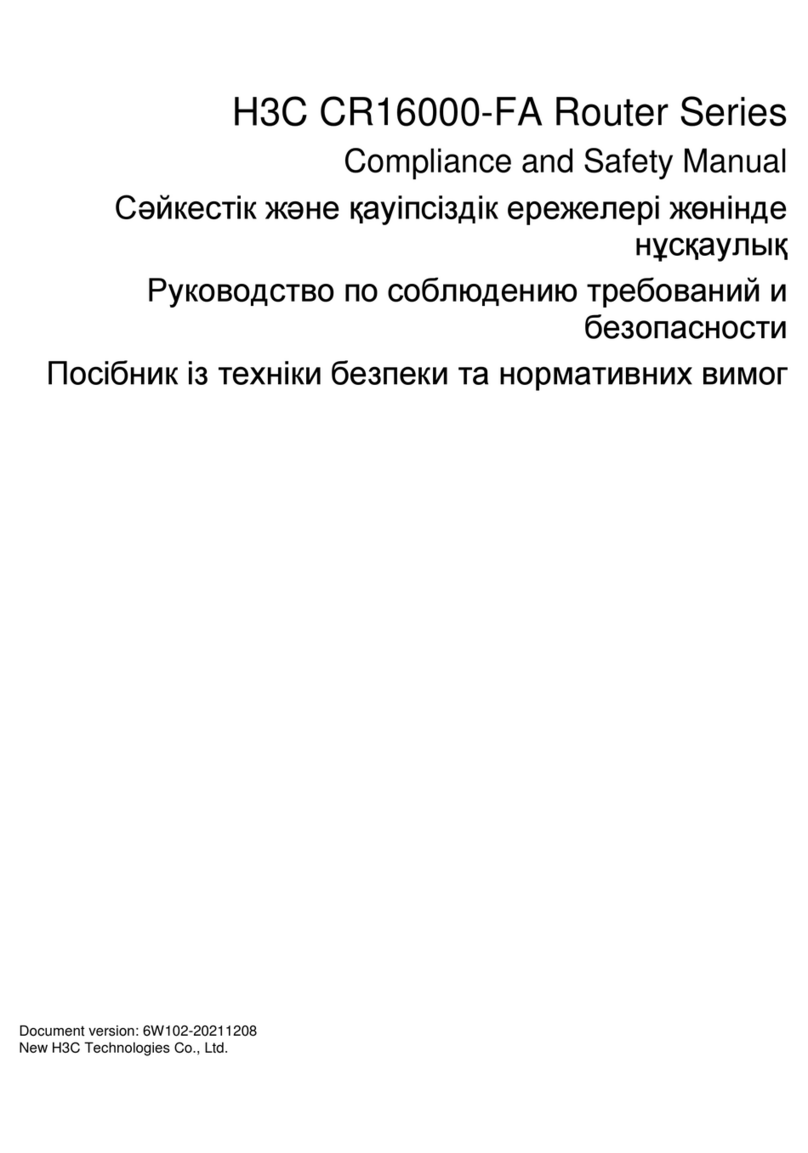
H3C
H3C CR16000-FA Series Instruction Manual
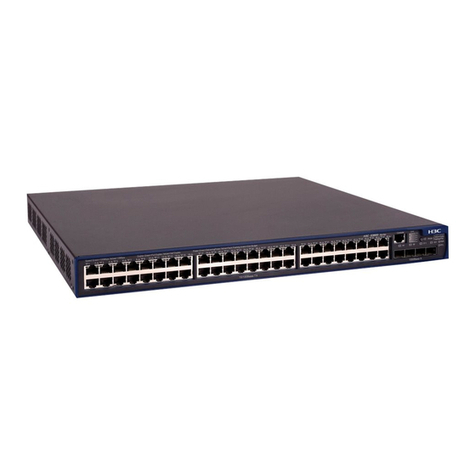
H3C
H3C H3C S3600 Series User manual
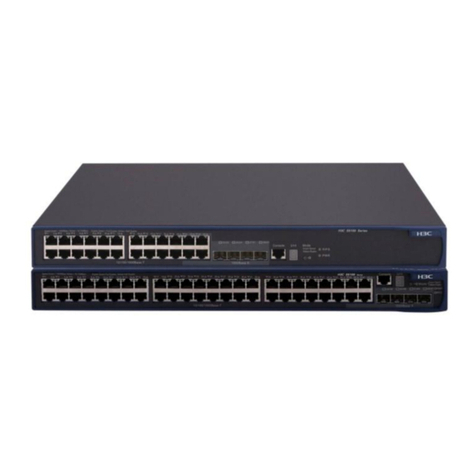
H3C
H3C LS-5100-16P-SI-OVS-H3 Quick guide
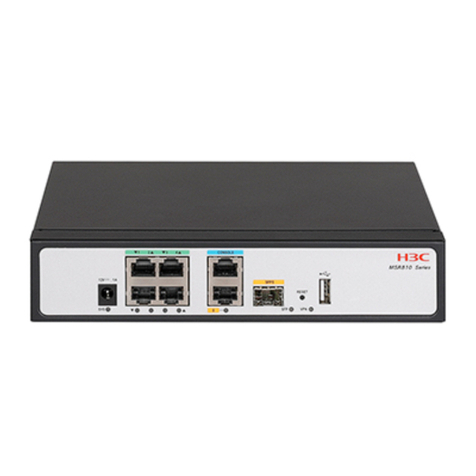
H3C
H3C MSR600 Series User manual
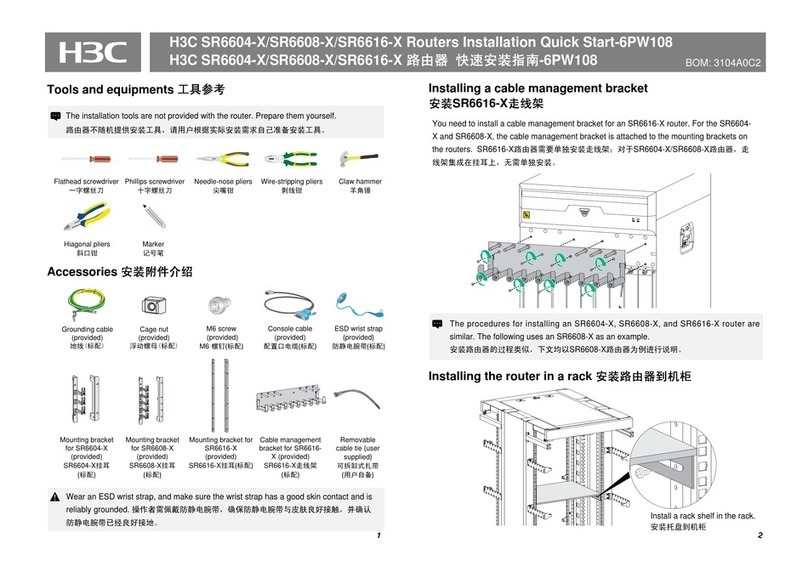
H3C
H3C SR6604-X Operating and maintenance manual
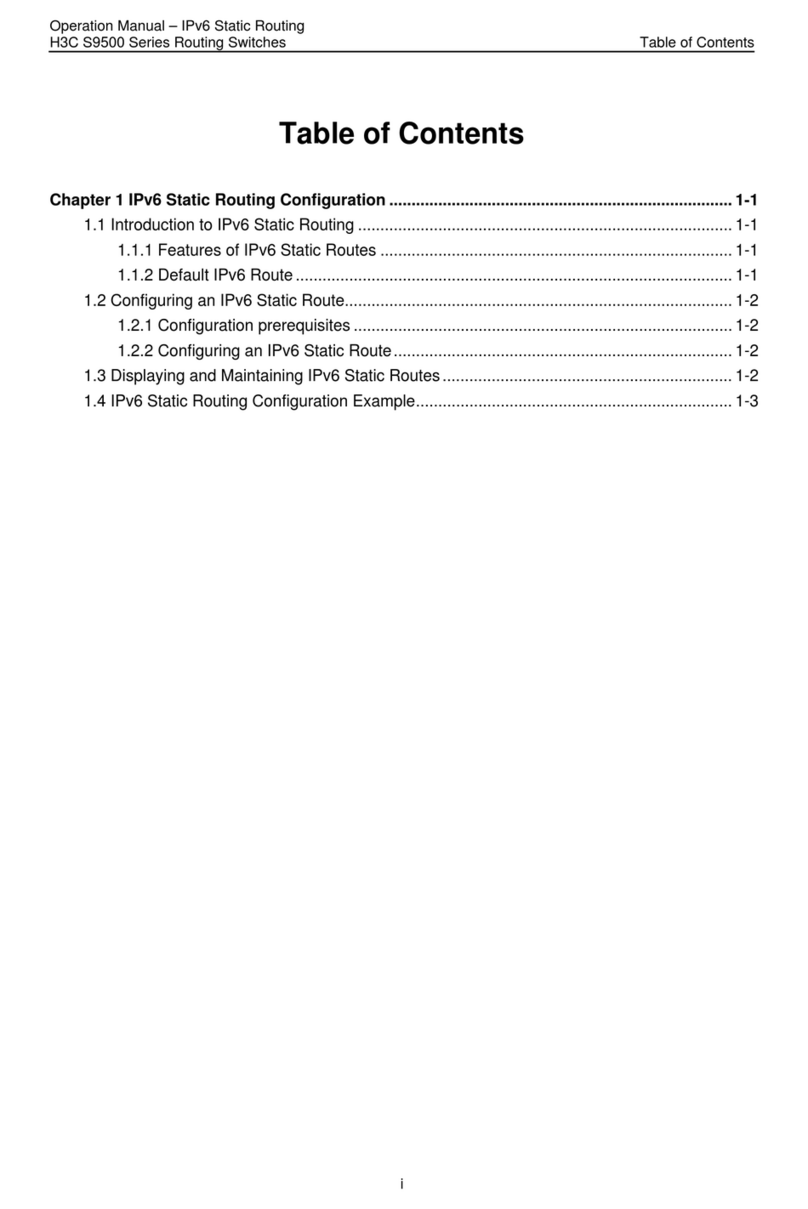
H3C
H3C S9500 Series User manual
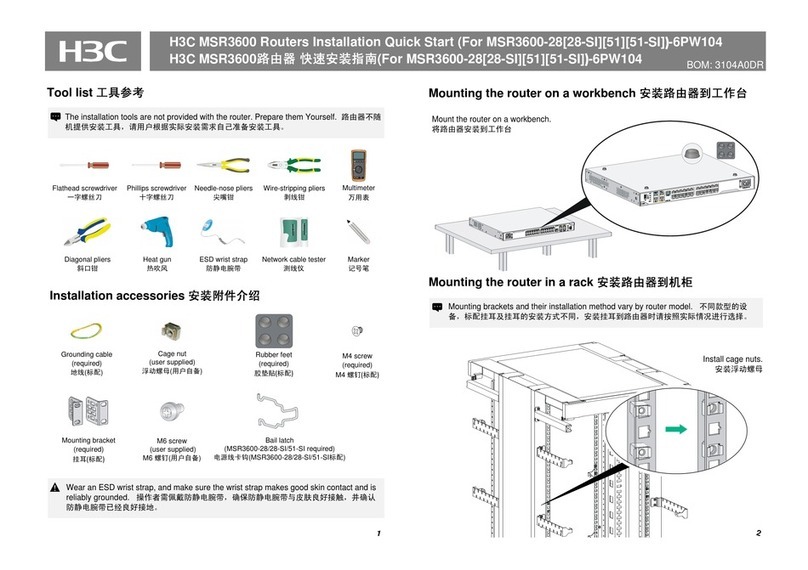
H3C
H3C MSR 3600 Operating and maintenance manual
